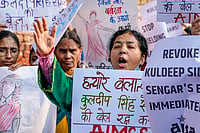- Emphasis on agriculture to boost production and productivity; ease supply constraints
- More allocations for education and health; forex reserves to be used for infrastructure
- No additional sops for industry or the markets since both are already on a roll
- Election and political concerns dictate the underlying philosophy behind the budget
- Expected measures to raise revenues by taxing cigarettes, forcing corporates to pay more
"If 1997 was a 'dream' budget to tell the world that India is readyto join the world, the 2007 budget is to tell the marginalised people that they are partof the economic process."
—Finance minister P. Chidambaram at his post-budget media conference
***
This sums up Chidambaram's Budget-e-aam. Some called it a socialist statement. Average and disappointing are words used by ceos to qualify Chidambaram's sixth, and the UPA's fourth, budget. The speech was prepared with one eye towards 10, Janpath, and the other at the forthcoming state elections in Uttar Pradesh and Gujarat. The FM's third eye, as it were, was focused on Sonia's favourite, the aam aadmi. Explains a senior source close to the finance minister, "It would be foolish for a politician not to be aware of the political side."
Whichever way one looks at PC's budget, the hidden hand of election economics is at play. There's almost nothing for industry, except for the lowering of peak rate of customs duty. The same is true for stockmarkets, with negatives like a hike in dividends distribution tax (DDT). Chidambaram's logic is that since both industry and stockmarkets were on a roll (though the Sensex shed 540 points on budget day), there was no compulsion to give more incentives and sops to them. Sunil Mittal, chairman, Bharti Enterprises, puts it succinctly: "It sends a signal that Corporate India, which has learned to stand on its own feet, should not just look at the budget for growth. The signal is that you guys are doing well, so keep it up."
But what was really missing in the budget was a vision and a long-term economic strategy. Agrees R. Seshasayee, MD, Ashok Leyland, "There were no path-breaking ideas." This when two of India's greatest reformers, Chidambaram and PM Manmohan Singh, had put their minds to it. For years, they have maintained that there's an economic consensus in the country on most issues, and politics can't impact reforms. This year, they showed us that politics has, at least in the short run, triumphed over economics.
To be fair to the FM, let's look at the budget from his perspective. During pre-budget discussions with his colleagues, PC realised that agriculture was the real laggard as far as the Indian economy was concerned. Both industry and services have clocked annual growth rates of over 11 per cent. However, the farm sector grew by a mere 2.3 per cent a year during the Tenth Plan period, compared to the desired level of 4 per cent. He found wisdom in Jawaharlal Nehru's comment that "everything else can wait, but not agriculture". So, he decided that it must have "the first charge on our resources".
But he hasn't done enough even here, say critics. The woes of most of the 115 million farming families stared him in the face. The fact that constraints in the supply of essential food items can upset macro-economic stability was also crystal-clear. Despite this, the budget hasn't sketched out a blueprint for a second green revolution, the detractors say. Explains M.S. Swaminathan, the doyen of the first green revolution in the 1960s, "Having identified the problem in both human and statistical dimensions, the budget fails to provide a strategy for agricultural renewal. The increase and expansion of farm credit is not going to prevent farmers' suicides."
Still, the FM has made a beginning, although he could—and should—have gone several steps further in this direction. But, hasn't he done it in the case of social sectors (education and health), employment schemes, social net for workers in the unorganised sector, and infrastructure? Even Chidambaram's supporters, who think that the need of the hour is to direct attention to these areas, say that the FM should have opted for more radical measures. Experts add that throwing more money at the problem is not a solution. The answer, as admitted by PC several times in his budget speech and also earlier, lies in dramatically improving the delivery system to ensure that the money reaches the right people.
Consider the means-cum-merit scholarship scheme that the budget has proposed to reduce the high dropout rate, especially in the ninth class. While it may work, it will only help 1 lakh children a year. More importantly, the chances of misuse are immense and there seems to be no mechanism to ensure that the child continues his/her studies till XIIth class. The real problem is that unless the system can augment the incomes of rural households, the families will be forced to make their children quit school and start earning. Even the social cover for unorganised workers will be a non-starter unless the state governments agree to fork out their share of 50 per cent of the premium.
After the Congress' electoral defeat in Punjab and Uttarakhand, attributed largely to increase in prices of food products, inflation was sure to form a critical part of PC's Budget. It did. Chidambaram did reduce the peak rate of customs duty, but that was expected even if inflation hadn't raised its ugly head in recent months as India is committed to reduce duties to match the lower ASEAN levels. The shock was the dual excise duty structure on cement. Dual pricing has invariably failed and leads to misuse and leakages. It reminded people of the past socialistic era, as did the increase in taxes on cigarettes. (In the 1980s, almost every FM did that to raise revenues.)
The pro-poor, and possibly anti-rich, philosophy underlying this budget was further enhanced by the move to tax export incomes (including software) in the near future, hike DDT, and impose fringe benefit tax on ESOPs. As Chidambaram himself admitted that corporate incomes should be taxed, DDT burdens the corporates, and ESOPs are given to senior (and obviously rich) employees. The idea was that those who had the propensity to pay should contribute to higher budgetary allocations for social sectors and infrastructure.
No one can deny the logic behind the aim of "inclusive growth". Both the UPA and the NDA have realised that good economics doesn't translate into good politics, that electoral results are not dictated by a 'shining' India. There's a need to allow the poor to reap the benefits of frenetic growth. There's a case for government intervention, rather than wait for the trickle-down effect. As Chidambaram said in his speech, "Revenues are buoyant for the third year in succession. I have put these revenues to good use to promote inclusive growth, equity and social justice—goals that are at the core of the National Common Minimum Programme and close to the hearts of the UPA, its chairperson and the prime minister."
It's the usage that's being questioned now. It's the lack of initiatives on the reforms front that's becoming a topic of discussion. It's the inability to draw a fine balance between economic needs and political pressures that's surprised the business community. Especially since Chidambaram is probably in the best position to do so. The economy is growing, both revenue and fiscal deficits are declining, the stockmarkets are booming, FDI and private investments are pouring into manufacturing, and revenues are increasing. The FM, therefore, is lucky enough to be able to simultaneously pump in more money into social sectors and provide a long-term economic blueprint that will ensure double-digitGDP growth in the 11th Plan period.
The fact is that Chidambaram hasn't done it this year. For this was possibly his last chance. Next year, when the general elections are around the corner—mid-2009 —he'll have no option but to present a "more political" budget.


























